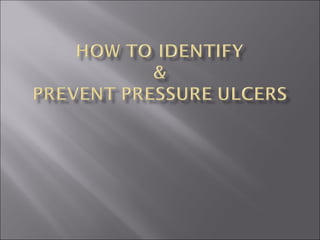
Ippu
- 2. Human body’s largest organ Body’s first line of defense
- 3. Protection Regulation Sensation Metabolism Communication
- 4. A sore caused by constant, unrelieved pressure to the skin and underlying tissue. The pressure comes from outside the body.
- 5. Pressure slows the blood flow to an area which leads to tissue death “Friction” and “shear” can add to the problem
- 6. Pressure ulcers most often form over bony areas on the body
- 7. Pressure ulcers are graded or “staged” to indicate the amount of tissue damage Stage 1, Stage 2, Stage 3, and Stage 4
- 8. There are “Risk Factors” that when present, make a resident MORE likely to develop a pressure ulcer
- 9. Poor nutrition Unintentional weight loss
- 10. Inability to easily move or reposition Incontinence
- 11. A resident who spends most of their time sitting in a chair or in a wheelchair, is also at risk for developing a pressure ulcer.
- 12. Inability to feel and report pain Lowered mental awareness
- 13. When you see even one or two of these risk factors, be on the lookout. This resident is at greater risk of developing a pressure ulcer.
- 14. Every time you change, help to the toilet, dress, bathe, transfer, and/or turn a resident... you have a chance to check and care for a resident’s skin.
- 15. An area of skin that is noticeably different than the surrounding area • It may look red, and the redness does not “fade” when the skin is touched, and released (blanched).
- 16. For residents with darker skin, the skin may look darker or lighter than the surrounding skin. Skin may look a little: red, blue, or purple in color.
- 17. Gently feel for a change in skin temperature: it may feel warmer or cooler than the surrounding area. A “suspicious area” may feel "spongy“ or "raised".
- 18. Look for areas of redness that are “non- blanchable*” Note: Redness should fade, when the skin is *touched and released.
- 19. Back of the head, ears, shoulder blades, elbows, tailbone, buttocks, hips, and heels.
- 20. Pressure ulcers usually form over a bony part of the body.
- 21. When you check a resident’s skin, be sure to have good lighting.
- 22. Skin Care Check the skin on daily basis. Check the skin while performing other care giving tasks Healthy skin is clean and moisturized, not dry, cracked, or scaly.
- 23. Nutrition and eating Encourage residents to eat and drink Assist residents with eating Feed residents unable to feed themselves Repositioning Turning Encourage residents to shift position
- 24. Positioning Encourage residents to make small shifts in position Keep head of bed at 30° or less Heels elevated off mattress supported by pillows under the legs Use a pillow to keep the knees and heels from rubbing together Turning Schedule for residents who cannot move by themselves
- 25. After turning or helping a resident shift their weight, use a pillow to support the new position in the bed or chair.
- 26. encourage small shifts in weight if the resident is able if a resident is on a turning schedule, be sure to stick to the schedule Prevention is the key
- 27. care for a resident’s skin (Healthy skin is clean and moisturized, NOT soiled, dry, cracked, or flakey.) Prevention is the key
- 28. encourage or assist a resident to eat their food and drink their water Prevention is the key
- 29. check a resident’s skin each time you change, help to the toilet, dress, transfer, bathe, or otherwise have an opportunity. Always be on the look-out
- 30. look for an area of skin that looks noticeably different than the surrounding areas especially on skin over the bony parts of the body Always be on the look-out
- 31. You have a great opportunity to positively IMPACT the health and well-being of nursing home residents.
- 32. If you see even a small change in a resident’s skin – TELL SOMEONE TELL SOMEONE, until you are SURE they hear you.
Editor's Notes
- Poor Nutrition Residents who cannot eat a healthy diet Poor appetite or unable to tolerate diet Can not feed themselves Poor dental health- Bad Teeth or dentures that do not fit properly or that are not used.
- Poor Nutrition Residents who cannot eat a healthy diet Poor appetite or unable to tolerate diet Can not feed themselves Poor dental health- Bad Teeth or dentures that do not fit properly or that are not used.
- Poor Nutrition Residents who cannot eat a healthy diet Poor appetite or unable to tolerate diet Can not feed themselves Poor dental health- Bad Teeth or dentures that do not fit properly or that are not used.
- Poor Nutrition Residents who cannot eat a healthy diet Poor appetite or unable to tolerate diet Can not feed themselves Poor dental health- Bad Teeth or dentures that do not fit properly or that are not used.
- What does it mean for an area of skin to be non-blanchable?
- What does it mean for an area of skin to be non-blanchable?
- What does it mean for an area of skin to be non-blanchable?
- What does it mean for an area of skin to be non-blanchable?
- What does it mean for an area of skin to be non-blanchable?
- Bony prominences that are at high risk areas High risk areas include buttocks, tailbone, back of head, hips, heels and ankles Other important sites include: ears, shoulder blades, elbows, mid-back thighs, lower legs, and toes.
- Bony prominences that are at high risk areas High risk areas include buttocks, tailbone, back of head, hips, heels and ankles Other important sites include: ears, shoulder blades, elbows, mid-back thighs, lower legs, and toes.
